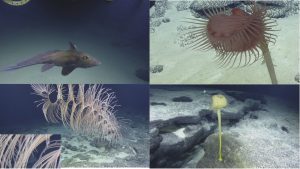Deep Sea Molecular Ecology Lab:
Biodiversity and Environmental DNA
Welcome! The Govindarajan Laboratory studies the biodiversity and ecology of the deep ocean ranging from the twilight zone to the deep seafloor. Much of our research focuses on the mesopelagic, or ocean twilight zone, but we have embarked on exciting new projects extending through deep pelagic waters to the benthos. Given the vast size of the deep ocean and the logistical challenges for studying these habitats, we develop and apply eDNA methods and autonomous sampling technology which we use in conjunction with a range of deep sea exploration platforms including AUVs, ROVs, and towed instruments.
Interested in getting involved? Please reach out to Dr. Annette Govindarajan at afrese@whoi.edu
Specific research topics include:
- Assessing mesopelagic fish and zooplankton distributions, particularly related to the phenomenon of diel vertical migration, and how these patterns relate to functional roles in food webs and biogeochemical cycling
- Exploring biodiversity and ecological connectivity in deep pelagic, seamount, vent, and trench habitats
- Development and application of autonomous eDNA samplers with in situ filtration (the "Oceanic-WHOI" samplers) coupled with AUV, ROV, and towed platforms; including the development and application of adaptive sampling
- Interpreting animal eDNA signatures by improving our understanding of the "ecology of eDNA" - how it is shed, where it goes and how it decays. We are also creating genetic reference databases for mesopelagic fishes

Recent Highlights:
- Exploring Seamounts with eDNA- Summer, 2025: We had an incredibly successful expedition on the E/V Nautilus where we used the ROV Hercules and large-volume autonomous samplers to obtain eDNA samples from never-before-explored seamounts in the Marshall Islands (NA174). Some of the amazing animals we observed are shown above!
- Deep Sea biodiversity exploration in American Samoa - Fall, 2024 We are exploring the biodiversity associated with the underwater volcano Vailulu'u, located near American Samoa and whether biological production associated with venting affects diel vertical migration of animals in the overlying water column. We are collecting eDNA samples with Mesobot and the Deep Autonomous Profiler to study how the volcanic activity animal life in the water column. Our expedition encompassed two incredible oceanographic cruises (NA164 and NA165) on the E/V Nautilus.
- If you have any interesting jellyfish sightings to share, please send an email to: jellyfish@whoi.edu!